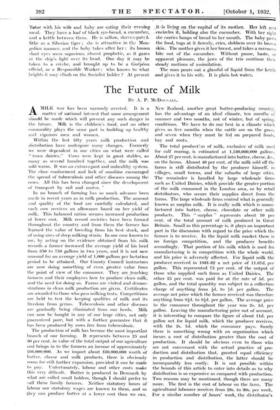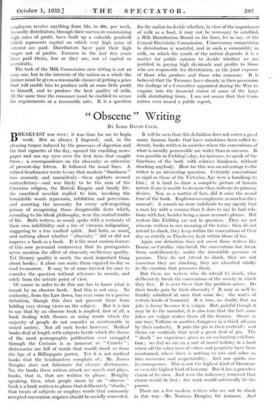The Future of Milk By A. P. MeDoucALL, A MILK war
has been narrowly averted. It is a • matter of national interest that some arrangement should be made which will prevent any such danger in the future. Milk is the children's food, and no other commodity plays the same part in building up healthy and vigorous men and women.
• Within the last fifty years milk production and distribution have undergone many changes. Formerly we were dependent in our cities on what were called " town dairies." Cows were kept in great stables, as many as several hundred together, and the milk was sold warm. It was an extravagant and unhealthy system. The close • confinement and lack of sunshine encouraged the spread of tuberculosis and other diseases among the cows. All this has been changed since the development or transport by rail and motor.
In no branch of farming has so much advance been made in recent years as in milk production. The amount and quality of the food are carefully calculated, and each cow receives an allowance -based on her yield of milk. This balanced ration secures increased production at lower cost. Milk record societies have been formed throughout the country and from them the farmer has learned the value of breeding from his best stock, and of using sires of deep milking strain. In one case known to me, by acting on the evidence obtained from his milk records a farmer increased the average yield of his herd from 350 to 750 gallons in two years, and it is not now unusual for an average yield of 1,000 gallons per lactation period to be attained. Our County Council instructors are now doing something of even greater value from the point of view of the consumer. They are teaching farmers and their employees how to produce clean milk, and the need for doing so. Farms are visited and demon- strations in clean milk production are given. Certificates are awarded to those who pass milking tests. Competitions are held to test the keeping qualities of milk and its freedom from germs. Tuberculosis and other diseases are gradually being eliminated from our herds. Milk can now be bought in any of our large cities, not only guaranteed pure; but with a further guarantee that it has been produced by cows free from tuberculosis.
The production of milk has become the most important branch of our farming. It represents between 25. and :30 per cent. in value of the total output of our agriculture and brings in to the farmers an income of approximately 4.66,000,000. As we import about £60,000,000 worth of butter, cheese and milk products, there is obviously room for still further expansion, provided it can be made to pay. Unfortunately, labour and other costs make this very difficult. Butter is produced in Denmark -by what are called small holders, though I should prefer to call them family farmers. Neither statutory hours of labour nor statutory wages are known to them, and so they can produce butter at a lower cost than we -can.. New Zealand, another great butter-producing country, has the advantage of an ideal climate, ten months of summer and two months, not of winter, but of spring, conditions. We have to do our best in a climate which gives us five months when the cattle are on the grass, and seven when they must be fed on prepared foods, hay and roots. - The total production of milk, exclusive of milk used for calf rearing, .is estimated at 1,130,000,000 gallons. About 27 per cent. is manufactured into butter, cheese, &c., on the farms.. Almost 40 per cent. of the milk sold off the farms is still distributed by the producer himself, in villages, small towns, and the suburbs of large cities. The remainder is handled by large wholesale firms such as United Dairies, which provide the greater portion of the milk consumed in the London area, or by retail Aistributors, who secure their supplies direct from the farms. The large wholesale firms control what is generally known as surplus milk. It is really milk which is manu- factured into butter, cheese, chocolate or other milk products. This " surplus " represents about 10 per cent. of the total amount of milk produced in Great Britain. Small as this percentage is, it plays an important part in the discussion with regard to the price which the farmer is to receive. In the liquid milk market there is no foreign competition, and the producer benefits accordingly. That portion of his milk which is used for manufacturing is in competition with the whole world, and his price is adversely affected. For liquid milk the producer received in 1931-32 a net price of 11.67d. per gallon. This represented 75 per cent. of the output of those who supplied such firms as United Dairies. The other 25 per cent. was paid for at the rate of 5d. per gallon, and the total quantity was subject to a collection charge of anything from id. to id. per gallon. The average net price which the farmer received was therefore anything from 90. to 9d. per gallon. The average price to the consumer throughout the year was 2s. ld. per gallon. Leaving the manufacturing price out of account, it is interesting to compare the figure of about 11d. per gallon net for liquid milk, which the producer receives, with the 2s. id. which the consumer pays. Surely there is something wrong with an organization which incurs a cost of distribution greater than the cost of production. It should be obvious even to those who are not conversant with the actual practice of pro- duction and distribution that, granted equal efficiency in production and distribution, the latter should be incomparably less costly. It is not possible within the bounds of this article to enter into details as to why distribution is so expensive as compared with production. Two reasons may be mentioned, though there are many more. The first is the cost of labour on the farm. The agricultural labourer receives from 28s. to 30s. per week. For a similar number of hours' work, the distributor's employeeS receive- anything from 52s. -to 60s., per -week. Secondly distributors,. through their success in-maintaining .high- rates • of profit, have built up a valuable goodwill which represents capital on which very high rates of interest are..paid. Distributors have • paid - their high wages out of profits. Farmers in the last five years have paid theirs, low as they are, out c.f capital or overdrafts.
The -task of the Milk Commission now sitting is not an easy one, but in the interests of the nation as a whole the farmer must be given a reasonable chance of getting a price that will enable him to produce milk at some little profit to himself, and to produce the best quality of milk. At the same time the consumer must be enabled to secure his requirements at a reasonable rate. It is a question -for the nation- to decide whether, in view of the importance of milk as a food, it may not be necessary to establish a Milk Distribution Board on the lines, let -us say, of the Central Electricity Commission. Unnecessary competition in distribution -is wasteful, and in such a commodity as milk, on which the youth of the nation depends, it is a matter for public opinion to decide whether we are justified in paying high dividends and profits to those who are responsible for distribution, at the joint expense of those who produce and those who consume. • It is believed that the Treasury have already in their possession the findings of a Committee appointed during the War to enquire into the financial status of some of the large milk distributing firms. I am not aware that that Com- mittee ever issued a public report.















































 Previous page
Previous page